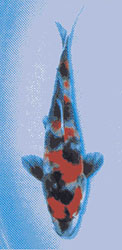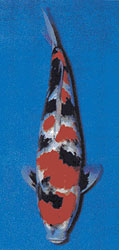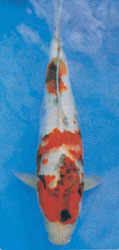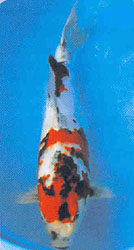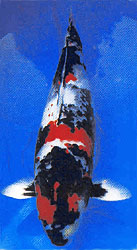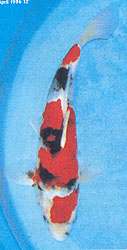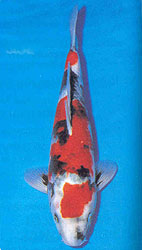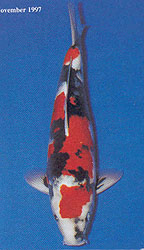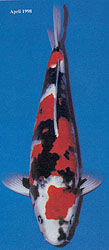"Beware of Koi Dogma" The most gratifying aspect of Koi keeping is to watch a Koi that is in your care develop and improve over time. To this end, the enthusiast is forever experimenting with new and improved methods of filtration, the latest advances in nutrition, and an unending parade of water conditioners, mineral additives, ozone generators and the like, all in hopes of helping our Koi reach their true potential. Although most of us have no qualms about trying and evaluating new techniques and products, many have a hard time letting go of old ideas that have been presented to us as fact. Sometimes, we are unconsciously hampered by unconscious adherence to beliefs in concepts that may or may not have a basis in experience, but have been sustained through repetition by some of the more "experienced" Koi keeping community. These concepts are often presented to the acolyte as Koi Dogma, to be accepted without question, but to be treated with great reverence and passed on to those who would follow. At a recent Koi show, two enthusiasts were discussing the potential future of a small Showa that was offered for sale. The prospects were looking great until a third, more experienced hobbyist came along and expounded, "It's common knowledge that the sumi (black) on the Showa gets darker, and more excessive as they mature. Anyone can see that this Showa has much too much black for a young Koi, and will probably become even darker as it grows older." The less "experienced" enthusiasts accepted this statement as dogma, and wandered off in search of a more suitable investment.
In November of 1995, Mr. Katsuhiko Tashiro, of Tokyo, purchased this 6" Showa from Magoemon of Niigata. With an evenly spaced hiban (red pattern) partially obscured by strong but blurred sumi, and an almost nonexistent white, this Showa would surly have become a victim of Koi Dogma had it been offered for sale in the United States. Note how the pectoral fins are completely overrun with black, dashing any hopes of a classic motoguro pattern. The sumi of the head shows promise of connecting in the much desired menware pattern, but "experienced" Koi keepers would warn us that this Showa has altogether far too much black. The second photo shows the object of Mr. Tashiro's esteem in all its glory as Grand Champion (43 Bu) at the 13th Rinyukai Young Koi Show. Still far from finished, the sumi has receded into a well-defined checkerboard pattern complemented by perfect motoguro. Balanced between the sumi and crisp white field is an impeccably spaced red pattern that leaves nothing to the imagination. The following example produced by Takeda Fish Farms of Hiroshima, illustrated the other end of the spectrum in the development of Showa. The first photo features a rather robust two-year-old, with excellent white skin providing the backdrop for somewhat unbalanced three-step pattern. The sparse black is scattered haphazardly across both the red and the white, making it difficult to predict what the future will bring. Dogma would dictate this to be a Kindai Showa.
Two years later, we see that the sumi has begun to emerge strongly on the shoulder and just to the rear of the dorsal fin, reaffirming the Kindai Showa appearance, but threatening to obliterate the third step. We can also see a clear indication of menware, and just a hint of gray beginning to appear at the base of the fins. Finally, as a majestic six-year-old measuring 30" long, our Showa shows her true colors, never again to be mistaken for a Kindai Showa. Her sumi has filled in beautifully, creating a strong counterbalance for her subtle, three-step pattern. With brilliant white, motoguro, and menware al perfected, she is the picture of the classic old style Showa. The last Showa featured in this article is quite possibly the epitome of textbook Koi development, and the ultimate dream of all Koi keepers. If we could dictate a step-by-step pictorial scenario of how the perfect Showa should develop, this might be what it would look like. Bred by Echigo Fish farms, this Showa was originally purchased by Koi No Taisho, a Japanese Koi dealer known to have a good eye for tategoi. Koi No Taisho kept the Showa in a concrete pond for about one year before it was purchased by Mr. Makoto Yanagihara of Toyoma Prefecture, in April 1996. Unquestionably Championship material, the Showa was impressive even at 12". In October of 1996, Mr.Yanagihara entered his Koi in the 5th Tachiyama Koi Show where it was chosen Best In Size 35 Bu.
For the year following the Tachiyama Koi Show, Mr. Yanagihara elected to keep the Showa at home in his personal pond. The results of his Koi Keeping skills became obvious at the 28th Rinyukai Koi Show in November of 1997, when the Showa, now displaying a proudly bold sumi pattern, was selected Champion 45 Bu. The ultimate dream of Japanese Koi enthusiasts is to compete successfully at one of the All Japan Shows. Among the most coveted awards are the Best In Size, or Kokugyo awards. Koi attaining this level of recognition are few and far between and are treated with great reverence. In April of 1998, at the 16th All Japan Young Nishikigoi Show, Mr. Yanagihara's Showa received the ultimate honor of Kokugyo 43 Bu. One could not ask for a more refined ambassador to convey to concept that is Showa. From the point of body confirmation, color, pattern, balance, luster, and poise, this Koi truly portrays the image of excellence. On the other hand, it would be sheer folly to demand hat every Showa be held to the light of this candle. The allure of Nishikigoi lies in the fact that no two are alike. When we impose overly rigid or unrealistic standards as a prerequisite for Koi appreciation, our capacity for learning and growth can only suffer. The important thing is to judge each Koi on its individual merits and above all, beware Koi Dogma!
BACK TO TOP |
||||||||||||||||||||||||||||||
|
|
||||||||||||||||||||||||||||||

